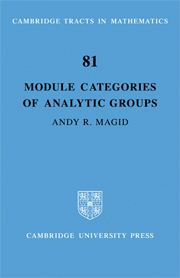Book contents
- Frontmatter
- Contents
- Preface
- Notation and conventions
- Introduction
- 1 Definitions and examples
- 2 Representative functions
- 3 Analytic subgroups of algebraic groups
- 4 Structure theory of algebras of representative functions
- 5 Left algebraic groups
- Appendix: Commutative analytic groups and characters
- Notes
- Bibliography
- Index
3 - Analytic subgroups of algebraic groups
Published online by Cambridge University Press: 07 October 2011
- Frontmatter
- Contents
- Preface
- Notation and conventions
- Introduction
- 1 Definitions and examples
- 2 Representative functions
- 3 Analytic subgroups of algebraic groups
- 4 Structure theory of algebras of representative functions
- 5 Left algebraic groups
- Appendix: Commutative analytic groups and characters
- Notes
- Bibliography
- Index
Summary
Let G be an analytic group and ρ: G→GL(V) a representation of G. We can regard the Zariski-closure Ḡ of the image ρ(G) of G as an analytic as well as algebraic group, and then ρ(G) becomes a Zariski-dense analytic subgroup of Ḡ. Such groups have some special properties, which we study in this chapter. We will show that every analytic subgroup of an algebraic group has a normal simply-connected solvable subgroup such that the quotient is reductive and, in fact, this subgroup admits a semidirect complement. If we start with an analytic group with such a semidirect product decomposition, we will show how to embed it as a Zariskidense normal analytic subgroup of an algebraic group such that the quotient is a torus and, in fact, admits a torus semidirect complement. The existence of this one special embedding can be used to show that the Zariski-closure of the image of any representation is generated by the image of the representation and a torus.
We will be dealing throughout the chapter with Zariski-dense analytic subgroups of algebraic groups. In our first proposition, we record some of the useful basic consequences of this situation.
Proposition 3.1 Let H be an algebraic group and let G be a Zariski-dense analytic subgroup of H. Then:
(a) If K is a normal analytic subgroup of G, K is a normal analytic subgroup of H;
(b) (G, G) = (H, H), so in particular G is normal in H and (G, G) is closed in G;
(c) If H is unipotent, G = H.
- Type
- Chapter
- Information
- Module Categories of Analytic Groups , pp. 58 - 80Publisher: Cambridge University PressPrint publication year: 1982



